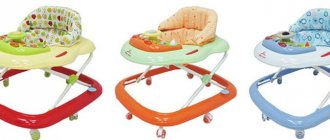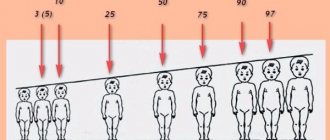When can you put your baby on his bottom? There are different conditions here that I will try to explain to parents. According to books, children sit down at 6-7 months, and in reality this happens. But in our practice, we constantly hear this question from mothers, especially those who have their first baby, and we also see that many children are not physically ready to sit at six months. In order for a child to sit, it is necessary to reach a physical age of 6-7 months, provided that the child was born full-term. sufficient strength of the back and abdominal muscles, a sufficiently developed vestibular apparatus for this skill, nothing should interfere with the child’s sitting (usually this is tone in the legs). Therefore, when wondering at what age children can be seated, you must first look at what the child can do, what his physical condition is, and whether he is ready to sit. In our practice, it happens that children are not ready to sit even at 10 months, although in such cases, with the right approach, i.e. gymnastics, they strengthen much faster than 7-8 month old children.
we plant the child
Do babies start at 4 or 5 months? Unfortunately, sometimes there are fans of very early development of children, but it is not recommended to sit a child before 6 months, because the baby’s bone skeleton still contains a lot of cartilage and deformations are possible under prolonged exposure to gravity. It is especially bad if the child is also supported with pillows so that he gets used to sitting. Do children sit at 6 months if they still don’t have balance and strength? Yes, at six months and older you can sit your baby down, but only as an exercise to strengthen muscles and train balance. Those. During a massage with gymnastics, the purpose of which is to teach the child to sit, you can sit the child for a short time, fixing it only with the hands of a specialist or mother. Typically, such exercises begin with 30 seconds and gradually increase the time every day. At first the child feels uncomfortable and hard, but gradually the baby finds balance, the muscles become stronger from the load and after 10 sessions the baby sits much more confidently.
Is it possible to sit a child at 4 or 5 months if he has strong muscles and asks to sit down? Usually mothers believe that the child wants to sit down when he raises his head from the surface on which he lies on his back or tries to bend forward, but at this moment the child is driven by the interest of looking at everything around from a more comfortable position, and new sensations from this skill, and Children sit down on all fours. I believe that no matter what muscles there are at 4-5 months of age, a child should not be put down. If the baby is strong, he will sit up on his own, but you should not help ahead of time. Another common question is whether it is possible to place a child at 6 months if it is a girl? For your peace of mind, you can sit girls from 7 months, although I have not seen any mention in educational books that it is harmful for girls to sit from 6 months. If a girl sits up on her own at 6 months, then you won’t be able to “put her down.”
What the statistics say
During the first year of life, the baby's development is characterized by intensity. Achievements of this age replace each other. Pediatricians have developed child development plans that outline the expected achievements of children by month and week. The average stats look like this:
- at 6 months the baby is able to sit with support;
- at 7 months - already without it;
- at 8 months – sits up independently from a lying position or lies down from a sitting position.
But since each child is individual, each has its own development path and its own time frame for achievement. Therefore, minor deviations from the indicators are also considered normal. So, in most cases, children begin to sit independently at 6 months of age. Well, if a baby starts doing this at 4 months or at 8 months, this is also not considered a pathology.
Here's what Dr. Komarovsky says about this:
https://youtu.be/Bsk1WUy-KFs
When can girls be imprisoned?
With the birth of a child, many questions arise related to caring for him and concerns about proper development. Children were raised by our grandparents, we ourselves were raised by mothers and fathers, and each parent who raised a child formed their own personal opinion about exactly how to deal with the baby. However, now we not only have many years of experience of our ancestors, but also have free access to knowledge and research in the field of pediatrics. This is a huge plus and advantage over the older generation and you need to use this knowledge and not rely on the advice of grandmothers.
Everyone has heard and repeats from mouth to mouth that girls should not be imprisoned too early. That supposedly this is fraught with bending of the uterus. Is it really? What does it mean to plant? What about must-have items like a car seat and modern gadgets like baby carriers, bouncers and bouncers? And when is it not “too early”? Perhaps you are looking for a specific answer, for example, that at 6 months it is already possible, but it is better to understand why exactly it is not possible.
What should precede sitting down?
Is it possible to force a child to sit down? In adults, the spine has natural curves. But babies are born with a straight spinal column; their curves develop later. The muscles of a child's back are not able to support the spine. This means the spine is vulnerable. Therefore, until a certain age, you cannot sit down your baby.
At 2-3 months, the baby begins to raise his head while lying on his tummy, thus the cervical curvature of the spine begins to form. When the baby masters independent attempts to sit up, the thoracic spine is formed. Well, when a child learns to stand on his feet and walk, the spine takes on the shape that is familiar to us. Therefore, correct posture will be formed in the baby only when he masters all the stages on his own.
If you start sitting down prematurely, the load on the spine increases. The muscular frame does not yet work and does not support the spinal column. The consequences of illiterate actions by adults can lead to disorders of the musculoskeletal system. The negative impact affects the condition of internal organs and respiratory organs.
The back muscles are strengthened during the baby's motor activity: holding the head, turning over, moving the arms and legs. These seemingly insignificant actions help strengthen your back muscles. And strengthening these muscles prepares the baby to sit down.
How the skeleton and muscles of the baby develop
Initially, at birth, the baby’s spine is designed only for a horizontal position. After all, a newborn does not have the natural curves of the spinal column. Their formation will take place over time, gradually. After all, they are responsible for the position of the back of a standing or sitting person. That is, children up to six months do not have a muscular frame, and the spine itself is unstable. It is not surprising that sitting down early can cause curvature of the spinal column. Moreover, in such cases, both the baby’s motor system, bones, muscles, and even internal organs begin to suffer, which will certainly affect their work.
In many ways, the answer to the question of when a child will learn to sit independently will depend on the development of the spinal muscles. It is also important to consider when the baby learns to lift and hold his head, roll over, etc. After all, it is these small actions that gradually strengthen the musculoskeletal system of the baby’s body.
In any case, only a pediatrician can answer the question of when you can start sitting down a baby without harming his health. At the same time, he will rely on the baby’s physique, the degree of activity of his actions, as well as muscle development. Often babies sit down even after they learn to crawl. After all, crawling is the most important stage in the development of any child. By the way, standing on all fours best promotes the development and proper formation of the spinal column and the muscles that support it.
When can you start sitting your baby down?
When can a baby start to be planted? The sitting time should not be determined by the baby’s age, but by his physical skills. Many mothers are interested in what age can a child be seated? If we talk about age, on average children sit between 4 and 8 months. The following indicators indicate that the baby is ready to sit down:
- the child confidently holds his head and lifts it from a horizontal position;
- the child can easily roll over from side to side, from back to stomach and vice versa;
- the child, grabbing the adult’s fingers, tries to give his body a vertical position.
If you observe all these signs in your baby, it means that he will soon begin to sit down on his own.
We draw your attention to the fact that even if a child under 6 months of age begins to sit down independently, he should be in this position for no more than 1 hour a day. Otherwise, problems with posture and other body systems may begin later.
Boy and girl sitting down
There is a myth that if you start placing a girl too early, she will develop a uterine inclination. This theory has not yet been confirmed by concrete evidence. If such a pattern exists, then the curvature of the uterus does not affect the conception, gestation and birth of a baby. However, it is advisable not to place the girl before 6-7 months.
As for boys, there are no specific risks observed.
What not to do if the baby is not yet sitting on his own
If the child does not even attempt to sit up, there is no need to help him.
Dangerous to the baby's health:
- make him sit with pillows around him;
- ride in a stroller with the back raised by more than 30°-45°;
- sit the baby on your lap;
- put the child in high chairs or walkers, jumpers.
You should not carry your baby in your arms. It is better not to use kangaroo-type carriers; ergo backpacks and slings are safer.
The dangers of sitting down earlier
At what age your baby will sit up depends on the individual rate of development. If you rush things, it will lead to the development of scoliosis. Problems can appear at the age of three, and in elementary school, when the load on the back becomes greater.
Early sitting down of a child leads to deformation of the pelvic bones. This is dangerous for both girls and boys.
There is a misconception that early seating of girls leads to a curvature of the uterus. This is wrong. This physiological feature is a consequence of genetic predisposition or chronic inflammatory diseases in the pelvis.
Should you put your baby on pillows?
Some generations are familiar with the expression “planting in pillows.” This is exactly the way our grandmothers taught babies to sit. Of course, this method is not correct, since with such actions we force the baby’s fragile back to take a vertical position, contrary to physiology. Several minutes of such forced sitting can lead to the appearance of scoliosis in a child at school age. It is correct to sit down when the baby begins to do it himself.
What else cannot be done until the child sits up on his own:
- plant in pillows;
- carry the baby in baby carriers and baby carriers;
- let him stand and walk in a walker;
- allowed to jump in jumpers, sit on a high chair;
- hold in your arms while sitting;
- When transporting in a stroller or car, use a sitting position.
It is important to note that with all this it is not prohibited to keep the baby in a semi-sitting position. Currently, there are many models of car seats, swings and other devices in which the backrest is adjusted to a semi-sitting position, reminiscent of the position of an embryo in the womb.
At what months can girls be put in walkers?
Children don't need walkers!
A child will be able to stand on his feet and learn to walk without this special device. Walkers make life easier for mothers who no longer know what to do with their little ones. After the first six months of life, the child begins to change rapidly, he becomes more active and curious, and the floor may not always be safe. Walkers very often help out mothers: active children happily walk around the apartment in them, a new vertical world opens up for them. Almost everyone knows what a walker looks like: it is a device on wheels with a seat inside and a limiting side. When the baby is wearing them, it frees up the hands of the mother, who can calmly go about her household chores, and the baby is happy to explore new territories.
So what's wrong with them? It may seem that a child using a walker will learn to walk and use his legs earlier. But in practice, everything is quite the opposite. This type of movement uses different muscles than real walking. The necessary formation of the spine does not occur, the stage of active crawling, which is so necessary to strengthen the back, is missed, plus children with increased/decreased tone may not fully stand on their feet, which will lead to the habit of walking on tiptoes.
Important!!! Walkers do not teach walking, and feeling safe with support, the child may subsequently be afraid to move independently.
Walkers are contraindicated for children suffering from rickets. If your baby insists on walking, and you are an ardent opponent of unnatural positions, then a walker cart may be a good alternative. This is a fairly heavy, stable toy that your baby can roll without assistance, while walking correctly on his own.
In any case, you can put a child in a walker (both girls and boys) only after he can independently hold his back straight without support and stand up on his feet in the crib!
How to help your baby sit up?
If a baby does not sit at 7 months, this does not mean that he has a pathology. Before you sit your baby down, you need to strengthen his back. Parents' actions should not be aimed at giving a vertical position to the child's body, but at preparing the baby to sit down. This preparation concerns the back muscles, which should be strengthened and trained. How to teach a baby to sit up on his own? Gymnastics and massage are wonderful methods for developing a baby’s muscular system, which will help teach him to sit.
Massage can improve muscle tone. It is advisable to entrust the massage to professionals, only they know how to properly massage the muscles. Well, if this is not possible, then at home the mother can stroke the baby’s back, tummy, as well as his arms and legs.
As for gymnastics, it can be done at home and must be done daily. Here is an approximate set of exercises:
- The baby lies on his tummy. The mother lifts the baby, holding her with one hand under her chest and with the other under her legs. In this position, the muscles of the back and buttocks tense. To let them relax, you need to put the baby in the starting position. And then repeat the exercise again.
- The child lies on his back. Mom holds the baby by the left hand and then gently pulls her towards her right leg. The baby finds himself in a half-sitting position. Then the mother gives the child the starting position. We do the same with the right hand. This is a great exercise for training the lateral back muscles.
- The baby lies on his back. Mom gives him the opportunity to grab onto her fingers. Then he begins to lift the baby, pulling his hand towards him. The baby's back lifted off the surface of the bed. It is necessary to hold the baby in this position for 15 seconds. Then, after a short rest, you need to repeat the exercise again.
A series of exercises with a child to strengthen the back muscles
What should parents do to help their child learn a new and necessary skill?
Every day, from 3 months of age, perform gymnastics and massage with the child, swim in the bathtub or pool (in large cities there are pools for joint use with young children). This way the muscle corset will be well strengthened.
From the age of four months, pediatricians recommend doing exercises to strengthen the back muscles. They need to be performed on a changing table or other hard surface.
Exercise 1. Pull-ups by the handles. The child is lying on the table. As soon as he reaches his arms towards his mother, extend his index fingers. The baby will try to sit up, grabbing his mother’s fingers. The child’s back lifts off the surface by 45 degrees; the baby is held in this position for several seconds and then returns to the “lying” position. This way the abdominal and arm muscles are trained.
Exercise 2. Airplane. Place the baby on his tummy. Raise the child, supporting him under the chest with one hand, and under the legs with the other. The legs rest against the adult’s chest, the buttocks and back are tense, the head is raised. Hold the position for a few seconds.
Exercise 3. Balance. Hold the child on your lap, reclining so that he rests his legs on the palms of an adult. This is how body balance develops and muscles are toned.
Exercise 4. Revolutions. From the “lying on his stomach” position, help the child roll over onto his back and back. This exercise will be easier to complete if your baby is interested in a bright toy.
Fitball exercises
The child lies on the ball with his stomach down. Leaning on the arms, the baby will try to keep the back straight, thereby training the muscles of the back and cervical region. At some distance from the ball, place bright toys and, rolling the child forward on the ball, allow him to try to grab any of them. During this game, the back muscles are well trained.
Valentina Ershova: How to teach a baby to sit
For the physical development of the baby, it is recommended to hang rings over the crib, which he can grab onto and try to rise up. When laying it on the stomach, place a bright object (toy) at a short distance in front of the baby, to which he will try to crawl.
Read also: How to make a newborn baby stronger: 4 basic exercises to develop your baby’s strength and endurance
It is important for every young mother to know how to sit down a child correctly (this has already been mentioned above) and what not to do.
If the child does not sit up on his own, then you cannot:
- Place him in pillows;
- Carry in a stroller in a sitting position (you can fix the back of the stroller at 45º)
- Carry in various Kangaroo-type carriers in a sitting position;
- Place on your hands (can be held on your knees in a “reclining” position).











